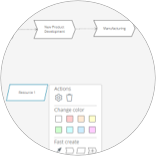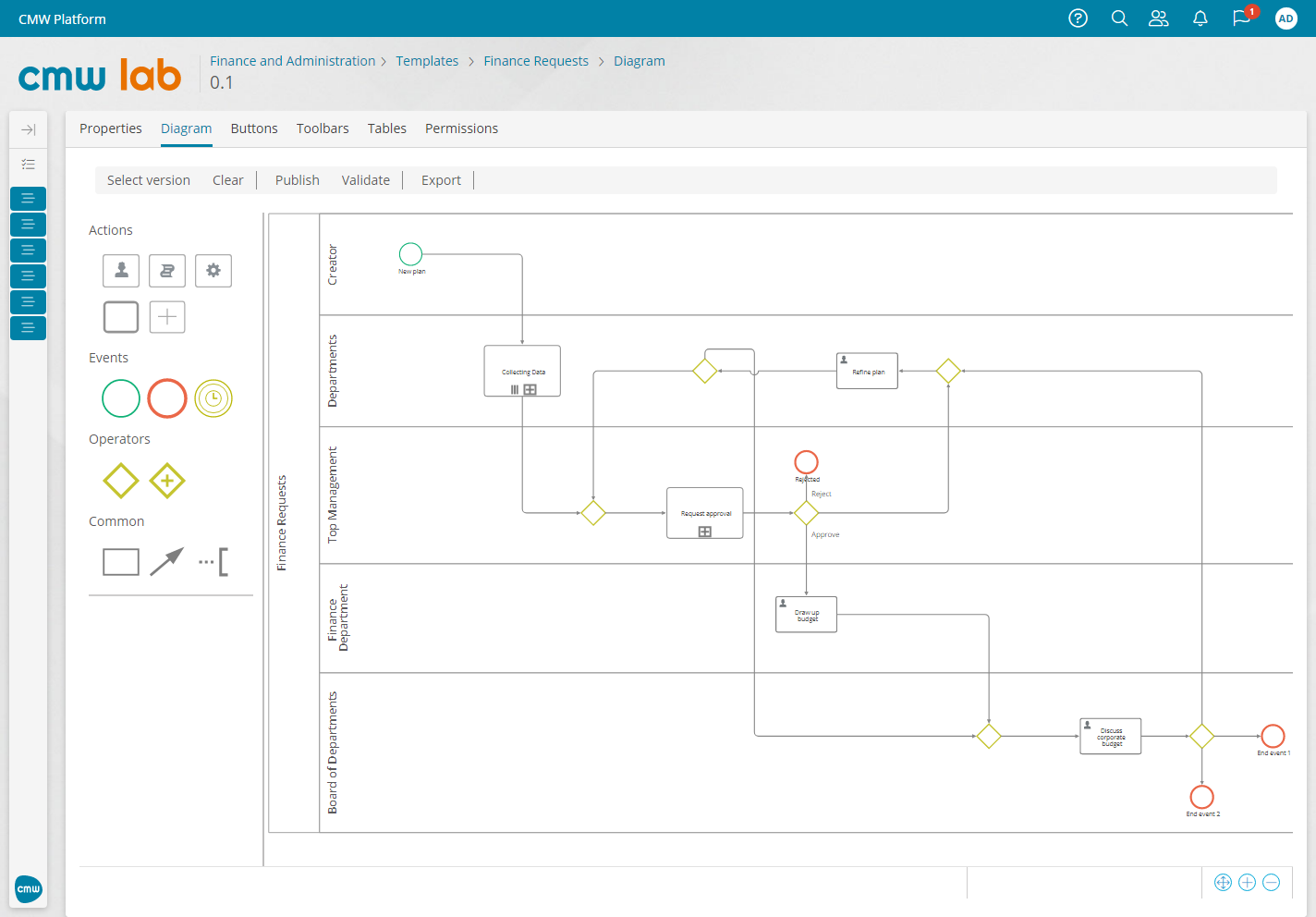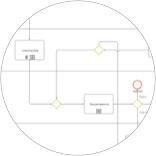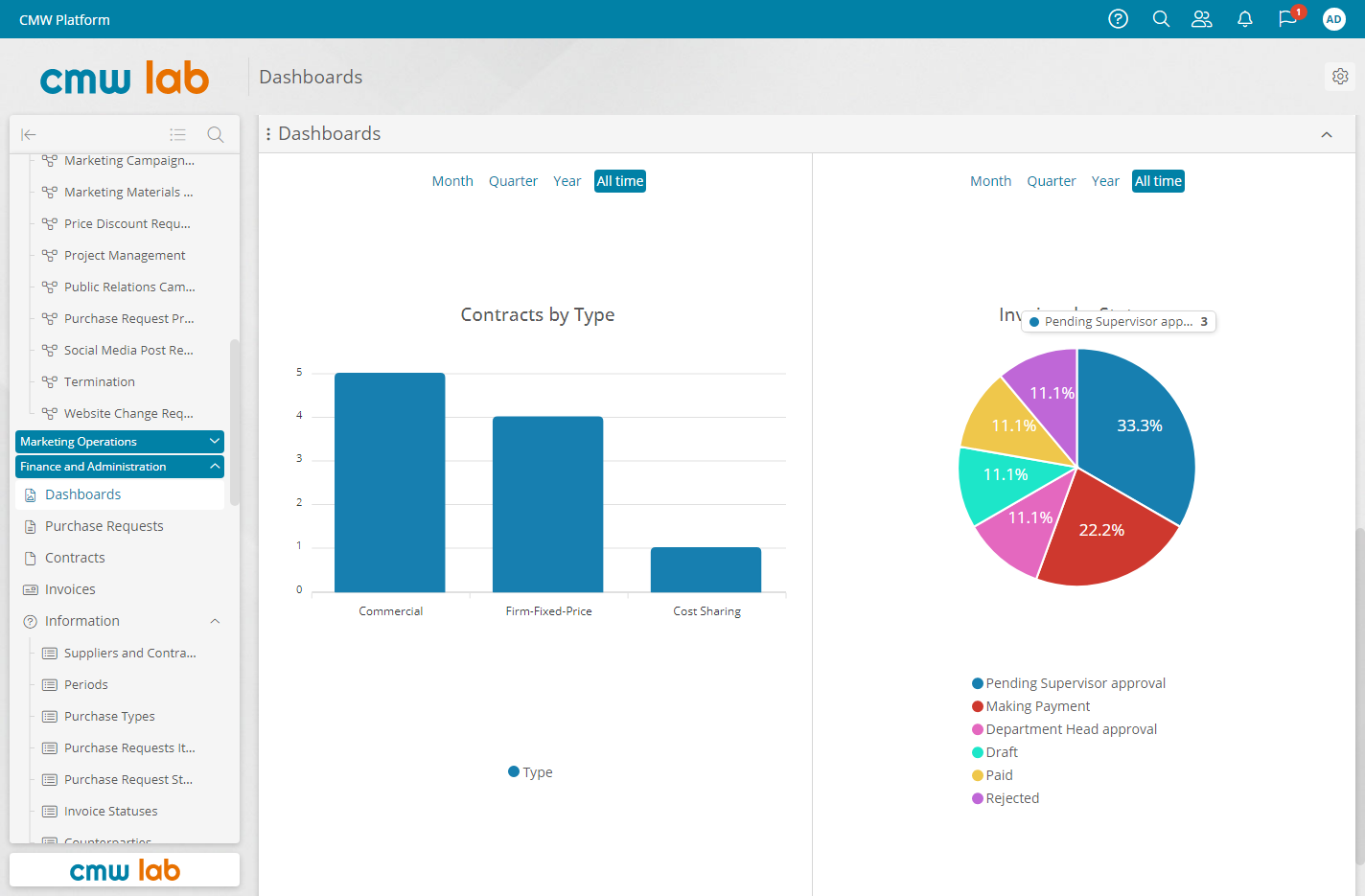CMW Platform increases practical participation of business people in creating innovative business applications and developing the IT landscape. Enjoy a full set of tools for modeling, executing, and optimizing the enterprise’s processes. Get the advantages of iBPMS (Intelligent BPM Suite) and Low-code platforms in a single digital environment:
CMW Lab flexibility is outstanding. It can adapt to custom requirements and processes, and enables us to automate and manage our work more efficiently. And that is exactly what we were expecting from workflow software.»

A graphical model of a business process is a basic component of business process management. It demonstrates the interrelationship of all process elements within the enterprise. Such representation helps to focus on the target and significant information for solving tasks of optimizing business processes.
CMW Platform provides flexible and convenient tools for modeling business processes even for non-technical users. Moreover, forms development, interface adaptation, and basic integrations configuration can be also performed by citizen developers simply in a web browser. Create a process diagram, define participants, and describe their set and sequence of actions using BPMN 2.0 as a global standard for BPM.


The success of process management in a company largely depends on the organization's ability to prioritize process optimization, focusing primarily on key business capabilities. A business capability is the combination of processes, people, and technologies that create value and align with the company's strategic goals. In other words, a business capability describes "what" a company is capable of doing, while business processes describe "how" the company implements its capabilities. A business capability model visualizes the entire range of specific business capabilities, and process architecture helps visualize the relationships between processes.
CMW Platform provides the ability to quickly build business capability and process architecture models, visualize the connections between processes, and link them to specific goals. Process Architecture Modeling is updated during optimization, which helps analyze the situation from a "top-down" perspective and effectively plan upcoming changes.


Depending on the selected settings, the business process can be started manually or automatically according to a schedule, incoming request, or condition. With the appropriate access rights, a user can obtain information about the previous and next steps of the process and visually evaluate its completion.
CMW Platform uses powerful process engine that:
CMW Platform ensures a process execution of the required complexity and decomposition level in a single environment.


Business process monitoring is one of the BPM tools that helps identify bottlenecks and respond to critical situations by adjusting the process flow or employee actions. Successfully address monitoring tasks with constant access to process statistics and data in a convenient format.
During the execution of business processes, CMW Platform collects detailed statistics on their metrics and indicators. Visual representation of this data simplifies the control of process execution, identifying the growth points. Comprehensive visual reports are also a source of information for redesigning complex business processes, fact-driven decisions, and adjusting process architecture.


Switching between multiple systems significantly slows down the work process. The task of a usiness process management software is to create a dedicated digital environment uniting other technologies (RPA, AI), internal information systems (ERP, CRM, etc.), and end-to-end business processes, eliminating the need to switch between different applications.
Start building your digital environment easily via the OData protocol and an open API.





Organizing business processes in a business process management solution involves building a business as a network of interconnected business processes. Automated processes establish the order of business operations and increase team effectiveness to achieve results. When implementing process management, businesses improve short-term results as well as long-term ones. This is due to the constant practice of optimizing business processes and their evolutionary development by business people.
CMW Platform includes a complete set of business process management tools that are part of BPMS software. Each tool included in the CMW Low-code platform is designed to meet the current demands of businesses for flexibility in both main and supporting enterprise business processes.
BPM is a systematic approach to process improvement, automation, and optimization aimed at increasing company-wide efficiency and achieving strategic business goals. It involves modeling, management, monitoring, and analysis of business processes for continuous improvement at all organizational levels.
Business management process software offers a plethora of proven benefits, among which are:
BPMS is the software used by companies to model, automate, monitor, and optimize their existing business process and workflows. It provides the necessary process management tools, ensuring internal procedures and operations are completed efficiently. BPMS typically includes tools for process mapping and process lifecycle management.
Overall, there are several types of business process management:
In essence, BPMS focuses on modeling, automation, and optimization of business processes while iBPMS incorporates additional functions fueled by AI/ML and RPA. iBPMS enables a deeper analysis and a more comprehensive process improvement.
Here is how BPMS allows businesses to automate their processes:
When selecting the right BPM solution for your business, it is crucial to consider the following factors:
Implementing a BPM solution streamlines customer interactions in the following ways:
Incorporating BPM solutions is beneficial for numerous industries and domains, including:
The distinctions between cloud and on-premises BPMS solutions lie in:
BPMS offers the following integration capabilities with other systems:
The following business processes can be improved and automated with BPMS:
To start using BPMS in your organization, follow these steps:
For small and mid-sized businesses, it is best to choose BPM tools that provide:
Training and user support in BPMS platforms typically include:
The key trends in business process management to anticipate in 2024 include:
All of these trends aim to enhance the overall efficiency, adaptability, and sustainability of business processes in rapidly evolving business settings.
Other components:
Become the digital transformation pacesetter